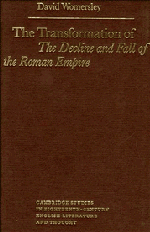Book contents
- Frontmatter
- Contents
- Acknowledgements
- A note on references and quotations
- Introduction
- PART I The historiography milieu
- PART II The Decline and Fall of the Roman Empire
- 3 Introduction
- Volume 1 - 1776
- Gibbon among the philosophers
- Volumes II and III - 1781
- 9 ‘The more rational ignorance of the man’
- 10 Julian the Apostate
- 11 Ammianus Marcellinus
- 12 ‘The nice and secret springs of action’
- Volumes IV, V and VI - 1788
- Appendix
- Bibliography
- Index
12 - ‘The nice and secret springs of action’
Published online by Cambridge University Press: 05 September 2013
- Frontmatter
- Contents
- Acknowledgements
- A note on references and quotations
- Introduction
- PART I The historiography milieu
- PART II The Decline and Fall of the Roman Empire
- 3 Introduction
- Volume 1 - 1776
- Gibbon among the philosophers
- Volumes II and III - 1781
- 9 ‘The more rational ignorance of the man’
- 10 Julian the Apostate
- 11 Ammianus Marcellinus
- 12 ‘The nice and secret springs of action’
- Volumes IV, V and VI - 1788
- Appendix
- Bibliography
- Index
Summary
So far in this second instalment of The Decline and Fall we have chiefly examined the changing surface of Gibbon's writing. Beginning with his acknowledgement of the greater difficulties his material posed for him in the years between 1776 and 1781, we considered, in his portrait of Julian the Apostate and his relationship with Ammianus Marcellinus, some of the literary consequences of this new historical terrain; consequences which stood out more clearly when we juxtaposed parallel elements of Volume I, such as the portrait of Augustus or the use made of Tacitus. We have, however, left untouched the question of the extent to which these new difficulties affected The Decline and Fall at the level of argument. How far and in what way does the stubbornness of the past influence Gibbon's explanation of the causes at work in history?
We might begin by recalling two innovations in Gibbon's historiographic practice which emerged in his dealings with Ammianus Marcellinus: first, that in his characterisation of the Roman nobles he seemed more concerned to depict the magnitude of decline than to explain it, and secondly, that over the long term the uneasy parity between Gibbon and Ammianus indicates that Gibbon is more immersed in the past than overlooking it. As we consider the handling of causality in 1781, the deep connexion between these two innovations will become clear.
- Type
- Chapter
- Information
- The Transformation of The Decline and Fall of the Roman Empire , pp. 182 - 192Publisher: Cambridge University PressPrint publication year: 1988

